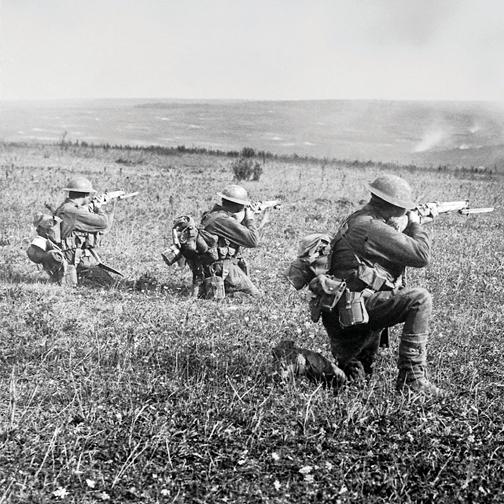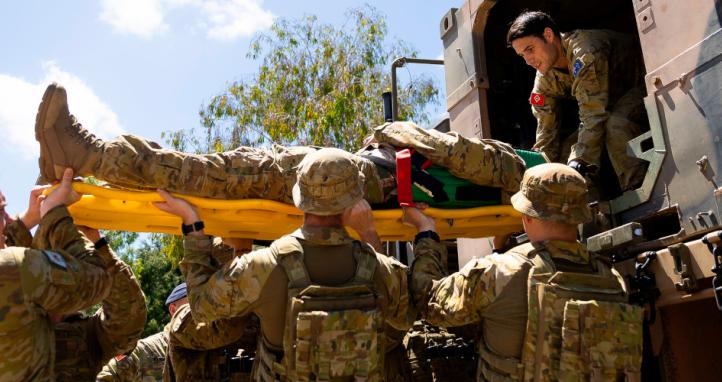Introduction
The proliferation of the internet, and with it, online shopping, presents a fundamental shift in how consumers conduct retail shopping. Instead of Original Equipment Manufacturers (OEMs) pushing their pallets of goods to physical department stores and retail outlets, e-commerce has consumers pulling goods and services to their front door. This ‘push-to-pull’ model has created a structural change in underlying supply chains and the movement of goods in terms of product flow, location of assets, delivery mode, and enabling and support technologies. Similarly, militaries have continually evolved and adapted their supply chains to a common and mission-optimised theme. Defined into lines or levels of support, military supply can be best summarised as an issue of item from one level down to the next level, which then triggers a demand for a replacement from the next level and so on. Stock appears to ‘flow’ sequentially down through each of the levels of support. The Amazon Effect, defined as the impact the digital marketplace has on the traditional retail business model (Coates, 2017) has the potential to revolutionise military supply chains, advancing logistics beyond the traditional centralised distribution network as the demand for immediate service emulsifies (Hu and Monahan, 2017).
Whilst many military logistics systems remain wedded to paper and clip boards, contemporary logistics businesses like Amazon are stepping a generation beyond their uniformed counterparts. Barcodes have given way to smart chips, QR codes, and RF identifiers. Road trains, hub and spoke, and sorting stations are being transformed, not just digitised. Dispersion and disaggregation are the commercial order of the day. The question then remains: how can military logistics catch up? Or alternatively, do commercial processes sacrifice resilience for speed in a way that militaries simply cannot do?
The Amazon Effect
‘The Amazon Effect’ has enabled anyone with internet access the ability to order anything at any time. Behind the scenes, the Amazon Effect is causing a revolution in supply chain operations. The expectation of 24/7 accessibility compounded with the ability for consumers to buy anything from anywhere; in stores and online; from phone, tablet, or computer; and pick it up or have it delivered by multiple options; has forced businesses to invest in technology and warehouse management systems to streamline back-end processes (Raines 2016). Traditionally, supply chain management was focused on cost savings through economies of warehousing, distribution, and transportation. Nowadays, improvements are continuously seeking to be responsive, agile, and the employment of the efficient technology and people (Raines 2016). According to White (Raines 2016), one element of an agile supply chain is fast electronic data, and the analytics to turn that data into decision-making information.
The transmission of orders from consumer to warehouse to transport nodes to distribution must be seamless (Raines 2016). It is well understood that the distribution of an item, or items, to an individual consumer, rather than a bulk warehouse centre, is costly and can be more complicated (Shorr 2015). Accordingly, new methods of inventory management are required. With the speed of the internet, software is required to fulfil multiple online orders efficiently: automation and scanners are needed. An alternate solution is to have the retail outlets to double as mini-warehouses, shipping between them as needed.
Speed-to-market plays a key role in the success of the supply chain (Raines 2016). Bringing the product closer to the customer is critical to reduce lead times (Raines 2016). However, it also means multiple warehouses in more unique locations with more overall inventory. Amazon realised the importance of speedy shipping to maintain customer satisfaction and attraction, and committed significant investment upfront through the introduction of more warehouses along their supply chain routes – with more than 100 warehouses in the USA alone, it has kept accelerating its delivery – from 48 hours, to next day, to the evening of the same day. Despite speed gains, inventory costs are raised due to having more trucks to move goods and more stocks in added warehouses.
Military Supply Chain Logistics
Supply chain management is, and always has been, an important characteristic of any military organisation. Napoleon Bonaparte is quoted to have said that ‘an army marches on its stomach’ – soldiers must have food, water, shelter, and medicine to sustain life. They must have a supply of weapons and ammunition and a means of transporting those items.
Army doctrine best characterises military logistics as the science of planning and carrying out the movement and maintenance of forces (LWP-CSS 4-1-5, 2007, p. xxxv). Military supply chain management is therefore an important characteristic of a military organisation because it is this maintenance of force that sustains life and operational capability.
The optimal military supply chain process consists of only two aspects: the customer (the soldier) and the supplier (the OEM). However, the need for a military organisation to provide continuity of support to operations often precludes the direct delivery from suppliers to combat units (LWP-CSS 4-1-5, 2007, p. 1-2). Therefore, supply chain resources are classified into Integral, Close, General, and Mounting Support:
Integral support represents the logistic capabilities necessary to provide unit viability at its designated readiness level, regardless of the assigned mission. This type of support has a limited operational viability period and requires the other types of support to provide sustainment for an ongoing period.
Close support is the support provided by a unit under the command of the supported unit and comprises of a ‘tailored’ combat service support capability aimed to provide responsiveness and balance linking force elements to the OEM and to extend or supplement the unit’s operational viability.
General support is the support provided to a supported force as a whole and includes combat service support activities carried out to greater depth where security and stability are needed to generate work which is ultimately to benefit the supported fighting formation.
Mounting support is where the projection and sustainment of a force requires a logistic bridge from the national and international support base to the theatre of operations.
With these levels of support, the military supply chain is a system leveraged off the economies of warehousing, distribution, and transportation (ADDP 4.3, 2018, p. 1-1).
The Amazon Effect in Context of Military Supply Chains
Global supply chain strategies such as the Amazon Effect can be mirrored within Military Supply Chains. Regardless of business or military settings, the outcome sought is to simultaneously achieve higher levels of end-user responsiveness at a lesser cost to the supply chain as a whole (Christopher and Towill, 2002, p. 1-14). The successes gained from the revolution of the Amazon Effect can be adapted to the military supply chain, and could revolutionise the future model of the lines of support. Indeed, military supply chain management has already adopted some Amazon Effect supply chain strategies, such as the design of standardised specific-containers and packaging to minimise inventory costs. Others, such as Cargo Visibility System (CVS) have been adopted to improve automation and process flow and are in use within the military supply chain.
The internet and increases in technological applications in supply chain processes demands software automation throughout the supply chain in order to be effective. Moreover, information technology can help by offering greater transparency of the demands placed within the supply chain pipeline [Coy, p14]. The introduction of barcoding to military equipment will instantaneously save time through automation of accounting and transaction management. Already, The Amazon Effect can portray an item’s stock on hand, time taken, and expected delivery date. Militaries are only realising the potential of barcoding systems, such as Automatic Data Capture Units with more efficiencies to be yielded. Seamless inventory management will revolutionise the supply of items to soldiers. Furthermore, errors caused through person-in-loop management of supply chain transactions generally result in supply chain delay or disruption. These will be minimised immediately, creating efficiencies.
Pull, or direct delivery, methods can enable operational capability with improved outcomes all whilst achieving economical savings and shorten lines of supply through running of items of supply from higher lines of support or even directly from OEM. Generally, this method will often be utilised for Class 4 (construction) and Class 7 (major item) supplies, or any item that is required in bulk (LWD 4-1, 2009, p7-10), but arguably any class of supply may be effected through direct delivery. The advent of the L121 Series of modular cargo transport vehicles, such as the HX77 and the use of flat racks, has given the military supply chain improvements in efficiency and effectiveness of direct delivery and collection methods (LWP-CSS 4-0-1, 2015, p3C-5), and not only limited to Class 4 and Class 7 supplies.
Drones may also revolutionise logistics support. They are and will be miniature in size and capable of flying in swarms while coordinating their actions thanks to software support. These flying robots will be capable to deliver small parcels of essential supply to any front. And once deployed, it would be very difficult to stop them, having been controlled remotely from a command post situated many hundreds of kilometres from the targeted area. Imagine a cloud of hundreds of drones, each carrying up to 5 kg of small arms ammunition, medical supplies, or essential nourishment to soldiers on the front line. Such a force of logistics equates to a massive amount of supplies.
Tactical Logistics Uncrewed Aerial Systems (LOG-UAS) for the Land Force recognise the Army’s requirement for industry-led innovations – exemplified by the “Amazon Effect” – to enable logistics resupply in high-risk combat scenarios and terrain otherwise inaccessible by road, since the Army currently deploys UAS for surveillance and reconnaissance but lacks platforms capable of conducting routine or combat resupply [Turner, 2022, p7].
A revolution within the military supply chain network is the introduction of more, yet smaller, warehouses. Seen as a fundamental shift in the operating model of a military organisation, the adoption of this concept will shorten lead times, bringing the consumer closer to the products and thereby improve supply chain responsiveness. A synergy that presents potential is to evolve military units into becoming mini-warehouses; converting them into nodes of the supply chain. Such a model will reduce the need for stockholding large quantities of equipment centrally.
Conclusion
Today, the internet has revolutionised retail shopping and generated a fundamental shift in supply chain operations from a push-to-pull model. The Amazon Effect, the ability to order anything at any time, with the inherent demand for next- and same-day service has pushed logistics beyond traditional hub and spoke models to more regular and frequent regional options in terms of warehousing, software implementation, and smart automation. With more commercial entities taking advantage of industry-led innovations and capabilities to reduce costs, there is also a parallel and corresponding efficiency to be gained in military supply chains. By updating supply chain management processes aligned to The Amazon Effect, a military unit can harness some of the same efficiencies via the sustainment of an operational capability.
In a doctrinal perspective, the lines of support define the levels of supporting logistic resources; however, the current relevance is in question. More regular placement of warehouses within the military supply chain network will harness efficiencies through increased responsiveness. The introduction of software automation applications will yield efficiencies and transparency in supply chain process management, particularly in the field of receipting and transmitting orders from warehouses to distribution modes. The routes must be seamless and software applications can be adopted to help achieve this. Direct delivery methods can be undertaken for reasons of economy through running of items from higher lines of support or even directly from suppliers. Military units, regardless of type, can be multi-assigned to act as mini-warehouses within the military supply chain network, therefore allowing shipping between them as needed.
References
Australian Defence Doctrine Publication (ADDP) 4.3—Supply, 2018, edition 3.
Christopher, M., and Towill, D. R., 2002, Developing Market Specific Supply Chain Strategies, The International Journal of Logistics Management, Vol. 13 Issue 1.
Coates, R., 2017, The Amazon Effect and the global Supply Chain, Available from: <http://www.scmr.com/article/the_amazon_effect_and_the_global_supply_cha…;, 15 Apr 2018.
Coy, P. (n.d). How to fix supply chain irrationality. The New York Times, p. 14.
Hu, M., and Monahan, S., 2017, ‘US E-Commerce Trends and the Impact on Logistics’, Available from: <https://www.atkearney.com/retail/article?/a/us-e-commerce-trends-and-th…; 15 Apr 2018.
Land Warfare Doctrine 4-1, 2009, Supply Support, Defence Publishing Service.
Land Warfare Publication Combat Service Support 4-1-5, 2007, Basic Storage and Warehousing, Defence Publishing Service.
Land Warfare Publication Combat Service Support 4-0-1, 2015, Combat Service Support In the Theatre, Defence Publishing Service.
Raines, L., 2016, “‘The Amazon effect’ changing logistics”, Atlanta Business Chronicle, Available from: <https://www.bizjournals.com/login/atlanta?r=%2Fatlanta%2Fnews%2F2016%2F…;, 31 Jul 2018.
Shorr Packaging Corp, 2015, ‘The Amazon Effect: Impacts on Shipping and Retail’, Available from: <https://www.shorr.com/packaging-news/2015-06/amazon-effect-impacts-ship…, 31 Jul 2018.
Turner, S., 2022, Ingenuity for the land force, Chief of Army Symposium, Army News, p. 7.










1. Culture - Amazon makes make rapid decisions, iterates quickly and invests in new tech without length procurement cycles – Army resists change, has procurement cycles that deliver end of life system and prioritises control and risk management.
2. Digitise - Modern capabilities such as automation, AI, cloud, analytics, and robotics are key to Amazon’s efficiency and pull architecture – Army uses dated, poorly integrated systems and wastes a brigade of pers doing manual labour or low value work while projects like ERP take a decade.
3. Decentralise - Amazon decentralises authority, allowing local nodes/teams to make fast, data driven decisions – Army’s top heavy, bureaucracy inhibits agility and rapid adaption to changing needs. I could deploy an AWS log solution from marketplace using infrastructure as code quicker than I could write the many briefs to justify a meeting to plan how to propose the initiative!
It would be nice for Army to adopt different systems quicker in order to pull items in a more efficient manner.
If only it wasn't a slow process to bring in a new system that is tried and tested by big organisations without having to have roadshows and CAMPUS/LXP courses for weeks to be able to operate them.
Alas, this is possibly a wish list, that the Army and perhaps the ADF will adopt new systems quickly, while they are still innovative and not outdated already.